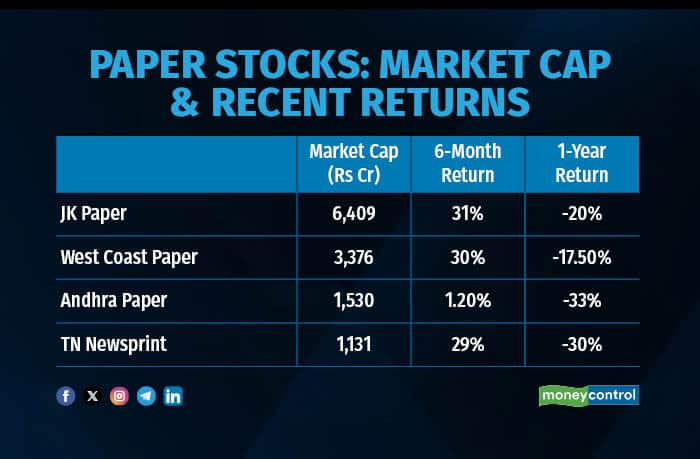



Paper stocks have had a strong run over the past six months, and the recent move by the government to introduce a minimum import price (MIP) for Virgin Multi-layer Paper Board (VPB), used as a packaging material, has supported gains on improved demand outlook.
Government Moves to Curb Cheaper ImportsThe Centre has imposed the MIP on VPB under specific Chapter 48 HS codes, likely until March 31, 2026. VPB is widely used in the packaging of products across the pharmaceutical, FMCG, electronics, cosmetics, liquor and publishing industry.
The move is aimed at curbing dumping of cheap imports, which has long been a challenge for domestic paper makers, and the industry has been seeking government intervention for the past 6-8 months. After the government action, the sector can expect some relief as cheaper imports will be curtailed, supporting domestic producers. In an interview with CNBC-TV18, AS Mehta, President and Director of JK Cement, said Indonesian players had created large new capacities and were dumping paper into India at very low prices. Mehta expects a price increase in the paper industry within the next 10-15 days.
MIP a Short-Term Boost?K Srikumar, Senior Vice President & Co-Group Head at ICRA said this one-time policy boost enhances the competitiveness of domestic players, but it offers little structural tailwind. "While the MIP is a positive development and should aid margins in the near term, it covers less than 10% of overall paper consumption. Hence, a sustained, long-term reprieve will be critical for any meaningful improvement in the sector’s credit profile," Srikumar said.
Factors at PlayThe MIP is not the only tailwind for the sector. A CareEdge report released in March 2025 said increased government spending on education positions the industry for long-term growth, with the printing and writing paper segment set to benefit from the National Education Policy (NEP) 2020. Companies have been on an expansion drive in anticipation, with Andhra Paper and Orient Paper announcing substantial capex, forseeing a robust outlook.
Tactical Boost or Long-Term Story?The question that now arises is whether the MIP boost serves as a long-term catalyst?
Market experts see a combination of policy support and festive demand as key drivers for paper stocks in the short-to-medium term.
"The MIP is set to boost pricing power for domestic players, improve revenue visibility, and lift profit margins. Alongside this, stable raw material costs, festive and educational demand, and ongoing capacity expansions add to the sector’s tailwinds. Put together, these factors strengthen the growth and profitability outlook for paper companies through FY26," said market expert Sunil Subramaniam.
Nirav Karkera of Fisdom Research echoed this view. "The government’s minimum import price on Virgin Multi-layer Paper Board levels the playing field against cheaper imports from China and other Asian countries. With the festive season around the corner, demand for packaging materials is expected to rise, benefiting these companies across the value chain. Easing input costs also bodes well for the companies and provide headroom for margin expansion. Combined with healthy balance sheets and strong operational capabilities, these factors point to medium-term sustainability and potential upside in earnings for the sector," Karkera added.
However, experts point out that the longer-term trajectory hinges on sustained demand, pricing trends, and the efficient management of added capacity.
Who Stands to Benefit?ITC could emerge as a big winner as the leader in this segment. While paper forms a small part of the conglomerate’s overall business, it can still move the needle, with 80-85% of volumes in its paper segment coming from paperboard. Experts suggest this could potentially double ITC’s profitability in this segment.
Speaking to CNBC-TV18, Amnish Aggarwal of PL Capital said, "Two years ago, ITC’s paper business had an EBIT of Rs 2,600 crore, and now it had literally halved from that level. Now that an import duty has been levied, particularly on paperboard, which is ITC’s forte as the market leader, profits could double over the next couple of years. Combined with the acquisition of Century Pulp and Paper, it will be significantly accretive to ITC over the next three years or so."
For JK Paper, VPB contributes about 35-40% of total paper revenue, and the company has a 18-20% market share which it expects to remain stable.
Paper Stocks Picking Up SteamThe recent policy tailwinds have coincided with a notable rally in select paper stocks over the past six months. JK Paper (market cap Rs 6,409 crore) and West Coast Paper (Rs 3,376 crore) have led the charge, posting 6-month gains of 31% and 30% respectively, while TN Newsprint (Rs 1,131 crore) has gained 29%. Andhra Paper (Rs 1,530 crore), however, has lagged with just a 1.2% uptick over the same period.
The one-year returns reflect the challenges the sector has faced, but the recent gains suggest these headwinds may be gradually fading, pointing to a more optimistic outlook for paper stocks.
 Paper stocks have picked up steam over the last six monthsDisclaimer: The views and investment tips expressed by investment experts on Moneycontrol.com are their own and not those of the website or its management. Moneycontrol.com advises users to check with certified experts before taking any investment decisions.
Paper stocks have picked up steam over the last six monthsDisclaimer: The views and investment tips expressed by investment experts on Moneycontrol.com are their own and not those of the website or its management. Moneycontrol.com advises users to check with certified experts before taking any investment decisions. Discover the latest Business News, Sensex, and Nifty updates. Obtain Personal Finance insights, tax queries, and expert opinions on Moneycontrol or download the Moneycontrol App to stay updated!
Find the best of Al News in one place, specially curated for you every weekend.
Stay on top of the latest tech trends and biggest startup news.